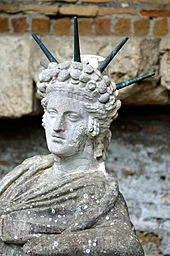
Attis, a life-death-rebirth deity, in Greek Mythology was both the son and the lover of Cybele, her eunuch attendant and driver of her lion-driven chariot; he was driven mad by her and castrated himself. Attis was originally a local semi-deity of Phrygia, associated with the great Phrygian trading city of Pessinos, which lay under the lee of Mount Agdistis. The mountain was personified as a daemon, whom foreigners associated with the Great Mother Cybele.
The story of his origins from Agdistis, as told to the traveller Pausanias, have some distinctly non-Greek elements: Pausanias was told that the daemon Agdistis initially bore both male and female attributes. But the Olympian gods, fearing Agdistis, cut off the male organ and cast it away. There grew up from it an almond-tree, and when its fruit was ripe, Nana who was a daughter of the river Sangarios picked the fruit and laid it in her bosom. It disappeared at once, but she was with child. In time a boy was born and exposed on the hillside, but the infant was tended by a he-goat. As Attis grew, his long-haired beauty was godlike, and Agdistis as Cybele, then fell in love with him. But the foster parents of Attis sent him to Pessinos, where he was to wed the king's daughter. According to some versions the King of Pessinos was Midas. Just as the marriage-song was being sung, Agdistis/Cybele appeared in her transcendent power, and Attis went mad and cut off his genitals. Attis' father-in-law-to-be, the king who was giving his daughter in marriage, followed suit, prefiguring the self-castrating Corybantes who devoted themselves to Cybele. But Agdistis repented and saw to it that the body of Attis should neither rot at all nor decay. (Pausanias, Greece, 7.19)
Attis was reborn as the evergreen pine. At the temple of Cybele/Rhea in Pessinos, the mother of the gods was still called Agdistis, the geographer Strabo recounted. (Geography, 12.5.3)
As neighboring Lydia came to control Phrygia, the cult of Attis was given a Lydian context too. Attis is said to have introduced to Lydia the cult of the Mother Goddess Cybele, incurring the jealousy of Zeus, who sent a boar to destroy the Lydian crops. Then certain Lydians, with Attis himself, were killed by the boar. Pausanias adds, to corroborate this story, that the Gauls who inhabited Pessinos abstained from pork. This myth element may have been invented solely to explain the unusual dietary laws of the Lydian Gauls. In Rome, the eunuch followers of Cybele were known as Galli, or "Gauls." (For the Gauls in Anatolia see Galatia.)
As the orgiastic cult of Cybele spread from Anatolia to Greece and eventually to Rome in the time of Claudius, the cult of Attis, her reborn eunuch consort, accompanied her. The Roman calendar was set thus: March 15 - Canna Intrat (procession of the reed-blowers); March 22 - Arbor Intrat[equinox]- (burial of Attis in effigy strapped to a stake; March 24 - Sanguis (day of mourning, sacrifice, and bloodletting); March 25 - Hilaria (day of Attis' resurrection); March 27 - Lavatio (day of ablution). A marble bas-relief of Cybele in her chariot and Attis, from Magna Graecia, is in the archaeological Museum, Venice. A finely executed silvery brass Attis that had been ritually consigned to the Mosel was recovered during construction in 1963 and is kept at the Rheinisches Landesmuseum of Trier. It shows the typically Anatolian costume of the god: trousers fastened together down the front of the legs with toggles and the Phrygian cap.
The story of Attis is the subject of one of the most famous poems by the Roman poet Catullus.
